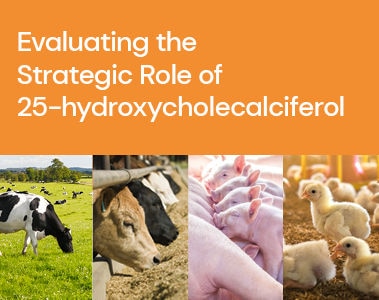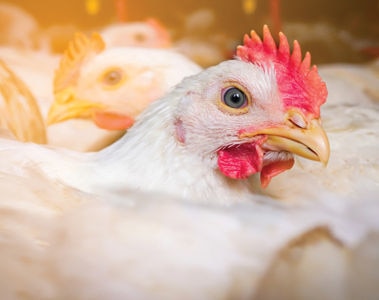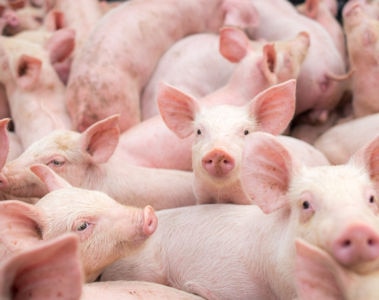Vitamin D3 (cholecalciferol) is an essential micronutrient, required for the calcification of the bones and ultimately for both optimum development and stability of the skeleton. Vitamin D regulates the homeostasis of calcium (Ca) and phosphorus (P) in the blood by increasing their absorption in the small intestine and promoting reabsorption in the renal tubules when blood concentrations fall below a critical level. Conversely, when plasma mineral levels exceed a maximum threshold, Vitamin D reduces absorption and enhances excretion. Furthermore, vitamin D3 influences the calcification process by increasing the uptake and promoting the deposition of minerals in the bones. The best-known and most dramatic endpoint of vitamin D3 undersupply is rickets. Further clinical deficiency signs in monogastric animals are inhibition of growth, loss of weight, reduced or lost appetite and high mortality.
Vitamin D3 can be endogenously produced by ultraviolet irradiation of the provitamin 7-8D-dehydrocholesterol, a process which typically occurs in the skin. However, as many modern farm animals are kept indoors with the absence of direct sunlight, their physiological production of vitamin D3 is negligible if at all possible. Therefore, dietary cholecalciferol is the most reliable source to cover the vitamin D requirement of farm animals (Soares, 1984).
After ingestion, cholecalciferol is absorbed from the intestinal tract with fats, and the presence of bile salts is needed for absorption. Via the lymphatic system, vitamin D3 is transported to the liver and is finally deposited in adipose tissues. Vitamin D3 in its native structure is biologically inactive and must be considered as a storage form. For exerting its important physiological function, it must be activated via a complex transformation cascade of 2 sequential hydroxylations.
First, cholecalciferol is converted in the liver to 25-hydroxy-cholecalciferol (calcifediol; 25-OH-D3). This form is released into the blood stream and thus represents the transport form of vitamin D. Since plasma concentrations of 25-OH-D3 appear to be directly correlated to the availability of vitamin D3, this metabolic step does not seem to be controlled or restricted (Clark and Potts, 1977). The second and final hydroxylation occurs in the kidney to 1,25-dihydroxy-cholecalciferol (calcitriol; 1,25-(OH)2-D3) (DeLuca, 1974). This last transformation to the active hormonal form of vitamin D is regulated by product inhibition via a short feedback system and by blood Ca and P levels through a long feedback system (Norman and Henry, 1979) under the control of the parathyroid hormone (PTH). Increasing the Ca plasma concentration inhibits the secretion of PTH, which concomitantly reduces the transformation of 25-OH-D3 to 1,25-(OH)2-D3 (Bell, 1985). In addition, calcitriol directly inhibits the 1a-hydroxylase and thereby reduces the further production of 1,25-(OH)2-D3.
There are alternative hydroxylation steps possible in the kidney, for example to give 24,25-dihydroxycholecalciferol or 1,24,25-trihydroxy-cholecalciferol. Although the trihydroxylated vitamin D3 has been demonstrated to be able to potentially replace 1,25-(OH)2-D3 as it binds well to the vitamin D receptor, its exact physiological function continues to be somewhat obscure. Likewise, 24,25-(OH)2-D3 did not seem to have a metabolic activity and therefore was considered to be mainly an excretion pathway for excess 25-OH-D3 in the early vitamin D literature. More recently, however, research of Seo et al. (1997) indicated a role of this metabolite for normal skeletal integrity and healing of bone fractures in chicks.



